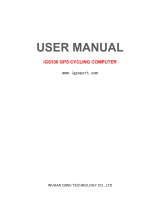
Table of Contents
Introduction.....................................................................1
Device Overview......................................................................... 1
Status Icons........................................................................... 1
Pairing Your Smartphone........................................................... 1
Installing the Standard Mount..................................................... 1
Releasing the Edge................................................................1
Charging the Device................................................................... 1
About the Battery................................................................... 2
Acquiring Satellite Signals.......................................................... 2
Viewing Widgets......................................................................... 2
Using the Backlight..................................................................... 2
Training........................................................................... 2
Going for a Ride..........................................................................2
Following a Saved Ride.............................................................. 2
Segments....................................................................................2
Strava™ Segments................................................................ 3
Following a Segment From Garmin Connect......................... 3
Racing a Segment................................................................. 3
Setting a Segment to Adjust Automatically............................ 3
Viewing Segment Details....................................................... 3
Deleting a Segment............................................................... 3
Courses...................................................................................... 3
Following a Course From Garmin Connect............................3
Tips for Training with Courses............................................... 3
Viewing Course Details.......................................................... 4
Deleting a Course.................................................................. 4
Training Indoors.......................................................................... 4
Marking Laps.............................................................................. 4
Using Auto Pause®.................................................................... 4
Using Auto Scroll........................................................................ 4
Changing Data Fields................................................................. 4
Adding a Data Screen.................................................................4
Deleting a Data Screen...............................................................4
My Stats........................................................................... 4
Setting Up Your User Profile.......................................................4
Personal Records....................................................................... 4
Viewing Your Personal Records............................................ 4
Reverting a Personal Record................................................. 4
Deleting a Personal Record................................................... 5
Navigation....................................................................... 5
Locations.................................................................................... 5
Marking Your Location........................................................... 5
Navigating to a Saved Location............................................. 5
Navigating Back to Start........................................................ 5
Viewing Saved Locations....................................................... 5
Viewing User Locations on the Map...................................... 5
Customizing the Map Icons....................................................5
Repositioning Your Location.................................................. 5
Deleting a Saved Location..................................................... 5
Bluetooth Connected Features..................................... 5
Garmin Connect..........................................................................5
Sending Your Ride to Garmin Connect................................. 6
Assistance.................................................................................. 6
Setting Up the Assistance Feature........................................ 6
Requesting Assistance.......................................................... 6
Cancelling an Assistance Message....................................... 6
Connect IQ Downloadable Features.......................................... 6
Wireless Sensors........................................................... 6
Installing the Speed Sensor........................................................ 6
Installing the Cadence Sensor.................................................... 6
About the Speed and Cadence Sensors............................... 7
Putting On the Heart Rate Monitor............................................. 7
Tips for Erratic Heart Rate Data
.............................................7
Fitness Goals......................................................................... 7
Recovery Time....................................................................... 7
About VO2 Max. Estimates.................................................... 8
Pairing Your Wireless Sensors................................................... 8
Training with Power Meters........................................................ 8
Calibrating Your Power Meter................................................ 8
Pedal-Based Power............................................................... 8
Situational Awareness................................................................ 8
History............................................................................. 8
Viewing Ride Details................................................................... 8
Deleting a Ride........................................................................... 9
Data Management...................................................................... 9
Connecting the Device to Your Computer............................. 9
Transferring Files to Your Device.......................................... 9
Deleting Files......................................................................... 9
Disconnecting the USB Cable................................................9
Viewing Data Totals.................................................................... 9
Customizing Your Device.............................................. 9
System Settings.......................................................................... 9
Changing the Device Language............................................ 9
Changing the Units of Measure............................................. 9
Turning the Device Tones On and Off................................... 9
Using the Auto Power Off Feature......................................... 9
Ride Settings.............................................................................. 9
Changing the Satellite Setting............................................. 10
Alerts.................................................................................... 10
Phone Settings......................................................................... 10
Setting Up Extended Display Mode.......................................... 10
Exiting Extended Display Mode................................................ 10
Device Information....................................................... 10
Specifications............................................................................10
Edge Specifications............................................................. 10
Heart Rate Monitor Specifications....................................... 10
Speed Sensor and Cadence Sensor Specifications............ 10
Viewing E-label Regulatory and Compliance Information........ 10
Device Care.............................................................................. 11
Cleaning the Device............................................................. 11
Caring for the Heart Rate Monitor........................................ 11
User Replaceable Batteries...................................................... 11
Replacing the Heart Rate Monitor Battery........................... 11
Replacing the Speed Sensor or Cadence Sensor Battery... 11
Troubleshooting........................................................... 11
Restarting the Device............................................................... 11
Restoring All Default Settings................................................... 11
Maximizing Battery Life.............................................................11
Improving GPS Satellite Reception.......................................... 12
My Device is in the Wrong Language....................................... 12
Replacement O-rings................................................................ 12
Updating the Software Using the Garmin Connect App........... 12
Updating the Software Using Garmin Express......................... 12
Product Updates....................................................................... 12
Getting More Information.......................................................... 12
Appendix....................................................................... 12
Data Fields................................................................................12
VO2 Max. Standard Ratings..................................................... 13
Heart Rate Zone Calculations...................................................13
Wheel Size and Circumference................................................ 13
Index.............................................................................. 15
Table of Contents i




















